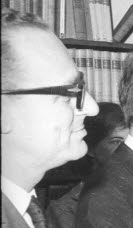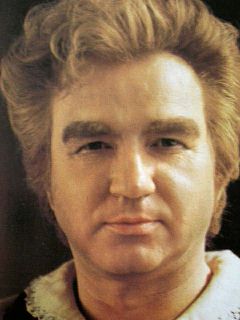
Michael Andreas Gielen was an Austrian conductor and composer known for promoting contemporary music in opera and concert. Principally active in Europe, his performances are characterized by precision and vivacity, aiding his ability to interpret the complex contemporary music he specialized in.

Hans Rosbaud was an Austrian conductor, particularly associated with the music of the twentieth century.

Gurre-Lieder is a tripartite oratorio followed by a melodramatic epilogue for five vocal soloists, narrator, three choruses, and grand orchestra. The work, which is based on an early song cycle for soprano, tenor and piano, was composed by the then-Austrian composer Arnold Schoenberg from 1900 to 1903. Following a break, he resumed orchestration in 1910 and completed it in November 1911. It sets to music the poem cycle Gurresange by the Danish novelist Jens Peter Jacobsen.

Von heute auf morgen is a one act opera composed by Arnold Schoenberg, to a German libretto by "Max Blonda", the pseudonym of Gertrud Schoenberg, the composer's wife. It is the composer's opus 32.

Moses und Aron, known in English as Moses and Aaron, is a 1975 film by the French filmmaking duo of Jean-Marie Straub and Danièle Huillet based on the unfinished opera of the same title by Arnold Schoenberg. During its 1975 run at US festivals, it was also known as Aaron and Moses, and was frequently reviewed as such.
Helmut Krebs was a German tenor in opera and concert, who sang a wide range of roles from Baroque to contemporary works.
Hans Herbert Fiedler was a German operatic bass and actor. He is best known today for portraying the role of Moses in the original 1954 production of Arnold Schoenberg's Moses und Aron.
Helmut Kretschmar is a German classical tenor who spent most of his career performing in concerts and recitals with major orchestras and at important music festivals internationally. Although he focused his career mainly within the concert repertoire, Kretschmar did appear two times on the opera stage, notably singing in the world premiere of Arnold Schoenberg's Moses und Aron in 1954. Possessing a rich and warm lyric tenor voice, Kretschmar excelled in the concert repertoire of Johann Sebastian Bach, George Frideric Handel, Joseph Haydn, and Felix Mendelssohn. Also an admired interpreter of Lieder, Kretschmar performed and recorded a number of works by Franz Schubert, Robert Schumann, and Hugo Wolf.
Der biblische Weg is a 1926 prose drama or play in three acts by Arnold Schoenberg. The plot of the drama deals with political aspirations in a modern setting, the downfall of the chief protagonist comes about through his attempt to combine the principles of both Moses and Aaron. Schoenberg used the play as an instrument of propaganda to promote the idea of a militant United Jewish Party. Although the play shares a biblical source of inspiration with Schoenberg's opera Moses und Aron, the play, a largely political work, has a very different focus from that of the opera, which is concerned chiefly with questions of theology and aesthetics.

Reiner Goldberg was a German operatic heldentenor who made an international career performing and recording. He appeared at the Berlin State Opera from 1972, and was a member of the ensemble from 1981. Goldberg achieved attention when he sang the role of Wagner's Parsifal for a 1982 opera film directed by Hans-Jürgen Syberberg. He then became known for performing the tenor roles of Wagner's stage works in leading opera houses in Europe and worldwide, such as the Bayreuth Festival where he appeared from 1986 as Tannhäuser, Stolzing in Die Meistersinger von Nürnberg, Siegfried in both Siegfried and Götterdämmerung, and Erik in Der fliegende Holländer. He performed at the Metropolitan Opera as Siegfried, conducted by James Levine and alongside Hildegard Behrens as Brünnhilde, resulting in a recording that won a Grammy Award.
Günter Reich, also spelled Günther Reich and Gunther Reich, was an Israeli baritone of German birth. He was a member of the Staatsoper Stuttgart for more than 20 years and is known for interpreting the works of Arnold Schoenberg in collaboration with Michael Gielen and Pierre Boulez.

Il canto sospeso is a cantata for vocal soloists, choir, and orchestra by the Italian composer Luigi Nono, written in 1955–56. It is one of the most admired examples of serial composition from the 1950s, but has also excited controversy over the relationship between its political content and its compositional means.

The NDR Chor is the choir of the German broadcaster Norddeutscher Rundfunk (NDR), based in Hamburg. It was founded in 1946, with Max Thurn as the first director of then 55 singers. The group has participated in premieres of contemporary music, such as the posthumous concert premiere of Schoenberg's opera Moses und Aron. It is also known for a capella music, introduced by Helmut Franz such as a recording of all such works by Johannes Brahms. The current artistic director is Philipp Ahmann, who has held the position from 2008. NDR Chor, now a group of 28 singers, is one of the leading professional chamber choirs in Germany.
Ursula Zollenkopf is a German classical contralto singer. A member of the NDR Chor based in Hamburg, she appeared as a soloist in opera and concert, including premieres of contemporary music such as Stravinsky's Threni and Schoenberg's Moses und Aron.
Max Thurn was a German conductor who was known particularly for his work as a choral conductor. He was the director of the choir of the Hamburg State Opera and of the NDR Chor, and was a co-founder of the boys' choir of the broadcaster Norddeutscher Rundfunk (NDR).
The EuropaChorAkademie is a German mixed choir, founded by Joshard Daus in 1997 as a group formed by students of two music universities, the University of Mainz and the University of the Arts Bremen. They have performed internationally and recorded choral works including Mahler's Second Symphony and Schönberg's Moses und Aron.

The WDR Rundfunkchor Köln is the choir of the German broadcaster Westdeutscher Rundfunk (WDR), based in Cologne. It was founded in 1947. The choir premiered works by contemporary composers including Arnold Schoenberg's unfinished opera Moses und Aron in 1954, Karlheinz Stockhausen's Momente, Luigi Nono's Il canto sospeso, Bernd Alois Zimmermann's Requiem für einen jungen Dichter and Penderecki's St Luke Passion.
Bohumil Herlischka was a Czech opera director. After years at the National Theatre, he worked from 1957 predominantly in German opera houses, introducing a style later known as Regietheater. He directed several productions at the Oper Frankfurt and developed a close connection to the Deutsche Oper am Rhein where he staged operas by Leoš Janáček, presenting a cycle of six operas in the 1977–78 season. He staged Schoenberg's Moses und Aaron at the Hamburg State Opera, including a tour to Israel. He focused on rarely played works such as Meyerbeer's Le prophète at the Deutsche Oper Berlin and on contemporary opera such as Shostakovich's Lady Macbeth of the Mtsensk District and the world premiere of Alexander Goehr's Behold the Sun.
Peter Hirsch is a German conductor, especially of opera. He has conducted several premieres, including Hans Zender's Stephen Climax at the Oper Frankfurt, and is focused on the work by Bernd Alois Zimmermann. Hirsch has appeared at international opera houses and festivals.
Hans Helmuth Chemin-Petit was a German composer, conductor and music educator.












